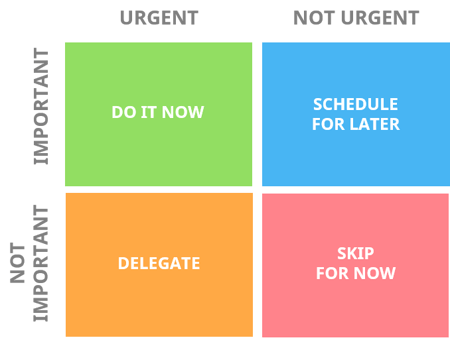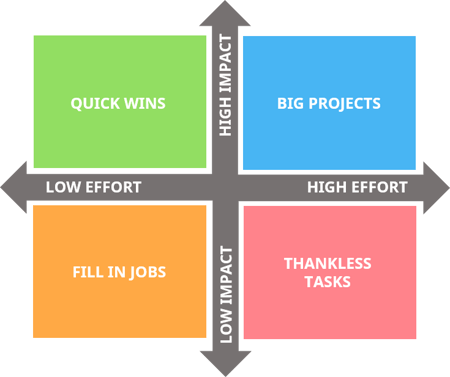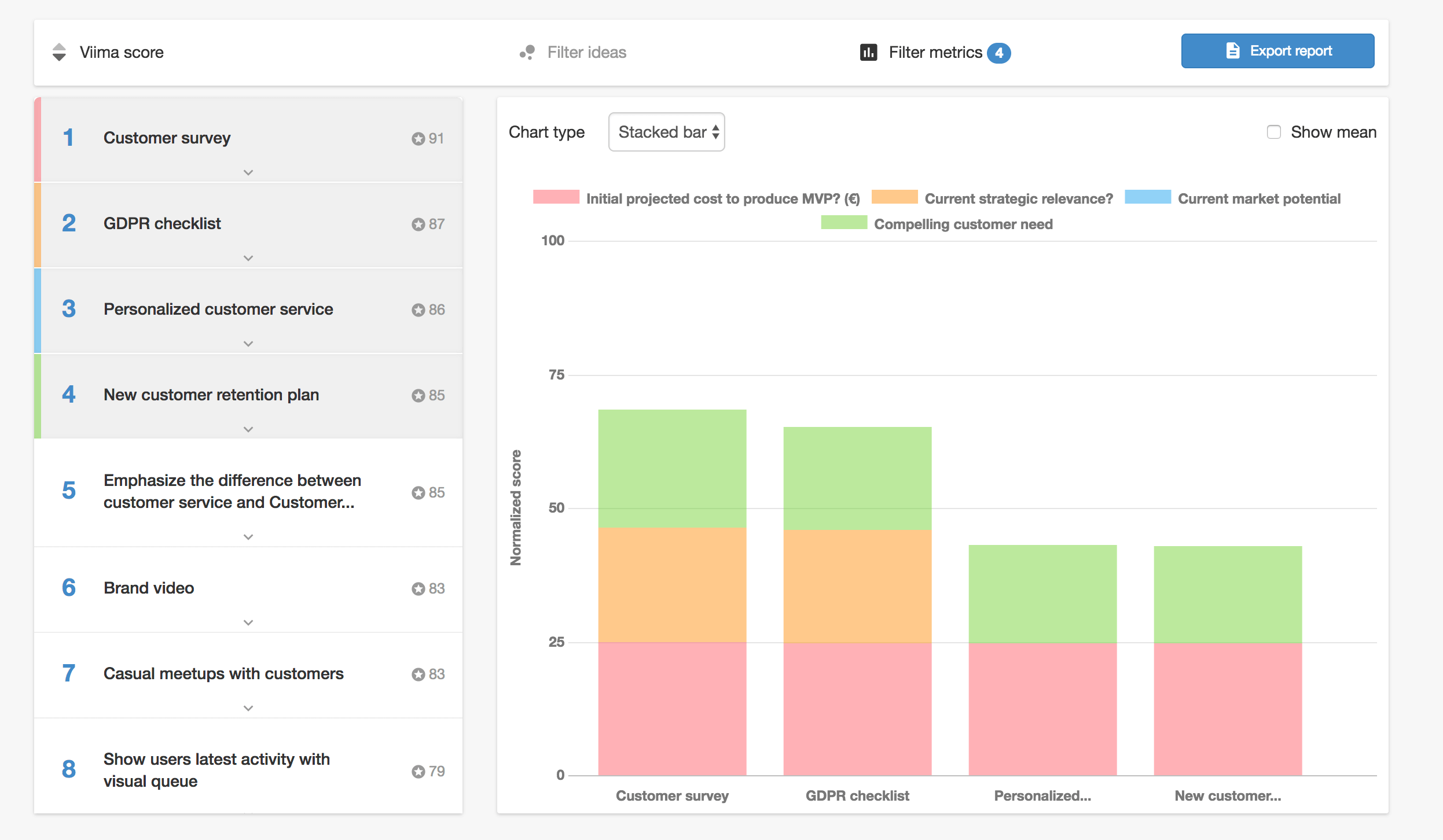Idea Prioritization – How to Succeed?
When executing ideas, people often need to decide between doing more and doing things well. Because doing things well takes time, and resources are rarely infinite, not all ideas can be executed at once.
When your time is scarce, it becomes expensive, and actualization of your ideas becomes more challenging.One of the questions we often get asked is “how to identify ideas that we should execute first?”
Although this isn’t always the easiest question to answer, we’ve decided to delve a little deeper into the topic by sharing a few effective ways to prioritize ideas so that you can execute them in a systematic manner.
In addition, we’ll share a five-step process for choosing the best approach for you to identify the brightest diamonds in the rough.
Table of contents

The Role of Idea Prioritization
The tricky part with most ideas is that you often cannot know in advance which ones are good and which ones aren’t – otherwise you’d obviously implement the good ones first and skip the bad ones altogether.
Many people tend to overthink and overanalyse, and what's even bigger problem is not analyzing at all. Effective prioritization is key to learning because you can only learn what works and what doesn’t after testing things out in practice.
Effective idea prioritization can help you to:
- Increase your productivity
- Make more educated decisions now and in the long run
- Increase transparency within your organization
- Make sure you’re working towards a desired outcome
However, before you’re able to prioritize and proceed with your ideas, you should understand what must be learned to succeed, and what must be done to learn to gather enough relevant data.
For example, let's say you've bought an old house you're planning to renovate. In order to succeed with your renovation project, you must learn a lot about the current condition of the house as well as the renovation process. To be able to prioritize the most important tasks, you need to evaluate which areas in the house need immediate repair and which tasks should be done later.
When it comes to ideas, a simple answer to these questions would be that ideas that are fast and cheap to implement and provide the most value are the ones that should be executed first. After all, making progress is all that matters.
Unfortunately, however, things aren’t always as simple as we’d like them to be. It’s good to keep in mind that there are different types of ideas and innovations, and because ideas often have different characteristics and levels of uncertainty, only similar ideas should be prioritized by using the same criteria.
Prioritizing different types of ideas
Often, the most common ideas coming from employees are small, everyday improvements related to existing ways of working, such as processes or product- and service development.
These so-called incremental ideas are generally rather easy to prioritize as they’re often quite straightforward.
However, not all ideas are as simple as innovation comes in different forms.
When it comes to new business ideas or innovations that are more disruptive by nature, applying the same prioritization criteria to all of them is often impossible or at least won’t make much sense.

What makes prioritizing new business ideas and disruptive innovations more difficult compared to incremental ideas has to do with Innovator’s Dilemma. The core of the dilemma is that normal and rational decision-making won't work when it comes to evaluating and prioritizing disruptive ideas.
Because these types of breakthrough ideas are quite rare in everyday work, people make the mistake of evaluating them with the same criteria. However, prioritizing new business ideas and disruptive innovation requires a different approach and should be handled separately.
So, due to the complexity and uncertainty of disruptive ideas, the models introduced in this post might be better suited for prioritizing incremental ideas.
If you’re interested in reading more about evaluating disruptive innovation, you’ll find more information about it in our previous post.
Models for Prioritizing Incremental Ideas
Although each idea is different and not all of them can be prioritized by using the same criteria, there are some common prioritization models that can be used as a reference when selecting your approach to prioritizing ideas.
While it’s good to understand that none of these models are perfect and none of them are able to reveal the whole truth about an individual idea, keeping these criteria in mind may help providing you with some structure to your idea categorization process.
The Eisenhower Matrix
The Eisenhower Matrix (also known as Urgent-Important Matrix), is a prioritization model that can be used to rank ideas based on the level of urgency and importance.
The model was invented and adopted by the former US president Dwight D. Eisenhower (1953-1961) who used to serve as a general in the US Army during World War II.
During his time in the war, he was constantly required to make tough decisions about which tasks he should focus on each day. The difficult conditions led him to invent this prioritization matrix that is used by many today.
Although the Eisenhower Matrix was originally created for task- and time management, it can be applied to prioritizing new ideas as well. Regardless of your use case, it’s more important to consider when to use the model and what you’re getting out of it.
In the Eisenhower prioritization matrix, the more urgent and important the idea is, the higher it’s prioritized.

- Urgent and important - Do it now
The do-it-now-ideas fall into the "urgent-and-important"-category. Ideas that belong to this quadrant should have the highest priority and will be implemented or tested first.
For example with the old house, an urgent and important tasks would be such as fixing the leaking roof or damaged pipes to prevent any further issues from happening. - Important but not urgent - Schedule for later
Ideas that fall into the “important-but-not-urgent”-category are the ones that can and should be scheduled for later.
These types of ideas are often related to topics that require long-term planning or more resources compared to the urgent matters, and therefore cannot be implemented right away. For example, strategic planning or organizing an idea challenge often belong to this category.
With these types of ideas, it should be kept in mind that the urgent matters often take care of themselves, which is why you should make enough room for ideas that are important but non-urgent so that no additional urgent problems would arise because of this.
- Not important but urgent - Delegate
The Eisenhower prioritization matrix suggests that ideas that need immediate attention but aren’t necessary on your prioritization list/are someone else’s expertise, should be delegated.
However, while this approach works in some cases, for example when receiving an urgent query your colleague knows more of, I’d still approach this advice with caution as delegation often takes time from you and your colleague and almost always requires a certain amount of follow-up.
If you’re always letting other people take care of things you don’t consider important, not only will it send a wrong signal and take up unnecessary time from both of you, it won’t necessarily help with removing departmental barriers or building a leaner company culture.
What is important is seldom urgent and what is urgent is seldom important. – D.Eisenhower
- Not urgent and not important - Skip for now
Needless to say, ideas that aren’t urgent nor important should be at the bottom of your to-do list. This, however, doesn’t necessarily mean the idea is born bad. It can also mean that the timing isn’t right for an idea to be developed and implemented.
Ideas that are not urgent nor important can be approached in two ways: in most of the cases, it’s ok to kill these types of ideas altogether so that you can focus on the more important ones. Often being able to throw unnecessary ideas into the trash bin can help with decluttering your mind as well as your to-do list.
In some cases, however, you might want to leave them for now and possibly come back to them later when you have gained more information about the topic or learned more about similar ideas.
If, however, you find out that you’re getting many ideas that cannot ever be implemented, you might want to communicate your strategy and what is expected from your employees more clearly. Often, when people understand what’s important and what isn’t, this issue is less likely to occur.
The Impact/Effort Matrix
Another matrix commonly used for prioritizing tasks and new ideas is the impact/effort matrix. The impact/effort matrix can be used for identifying ideas that appear to require the least effort to implement while having the most favorable impact on your business.
This prioritization model has the same structure and ideology as the Eisenhower Matrix; the level of effort required to implement an idea is placed on the x-axis and the level of perceived impact on the y-axis.

Just like the previous model, this one also has four quadrants of which the first and the second one are the ones that should be implemented first. In other words, the lower the effort required to implementation and the higher the impact, the better.
However, instead of treating these factors as equals, you should focus on ideas that have the most impact and will help you to move to the right direction.
- High impact, low effort - Quick wins
Quick wins are ideas that can be an be executed right away. These types of ideas are easy to implement and appear to have a high positive impact on your business.
These quick wins or so-called “low-hanging fruit” are ideas that should be continuously looked for and taken care of in an timely manner. Executing these types of ideas is great especially when you want to learn what works and what doesn’t fast without having to invest much of your resources.
In addition, ideas that have a high impact but are easy to implement works well when you’re introducing a new way of doing things. In order to get your team on board, focusing on quick wins might be worth considering because your team is able to see the results fast with low effort.
- High impact, high effort - Big projects
As already mentioned, larger innovation projects require more planning and resources compared to smaller improvements.
The biggest projects often have the highest impact, but because the implementation and results also takes more time, they often cannot be executed immediately. You might, however, want to prioritize and get started with these bigger projects as soon as possible, so that they will be get done in time.
Your new house isn't going to renovate itself, which is why you might want to start working on it right away so that you’ll be able to actually finish your project some day. Same applies to bigger projects at work as getting started is often the most difficult part.
- Low impact, high effort - Fill in jobs
In general, ideas with low impact and high effort aren’t worth pursuing as it will provide minimal results with a large cost.
These types of ideas should be eliminated fast, but if this isn’t possible, try to gather more information about the idea before spending any time on it.
- Low impact, low effort - Thankless tasks
Thankless tasks are often ideas that aren’t necessarily the most important and exciting ones but shouldn’t require much effort either.
If these types of ideas cannot be skipped altogether, try to execute them as efficiently as possible.
When it comes to "low-impact-low-effort ideas", you can also try to see if there’s a way to somehow increase the impact of that idea.
Does the idea require more resources? Should it be tested in another environment to become more impactful?
If you think you’re able to increase the impact without increasing the effort required to implement that idea, it might be worth giving a shot.
Benefits and limitations
These prioritization matrices can help categorizing your ideas into different types and analyse them from a practical point of view. When dealing with a ton of incremental improvement suggestions, these matrices can help you with making more informative decisions.
It can also help kick off your prioritization process if you’re not quite sure where to start.
However, as already mentioned, these matrices also have some limitations. As they’re just simple frameworks, they cannot be used as a replacement to your individual prioritization criteria.
There’ll always be exceptions and not all ideas can be prioritized the same, which is why an individual approach for prioritizing your ideas is the key.
In the second part of this post, we’ve combined our best tips for creating one that works for your purposes.
Choosing Your Approach for Idea Prioritization
The second part of the post aims for helping you to find a set of prioritization criteria that can be used for more effective identification of potential ideas.
Although prioritization is just a piece in the big puzzle of idea management, the ability to make smarter decisions certainly has other positive ripple effects as well.
Not only will it make your work easier, it can also enhance transparency so that everyone knows what makes an impactful idea and which type of ideas should be encouraged and looked for in the first place.
Whether you should pilot, make a prototype, test or simply just go and execute an idea, depends on the nature of that individual idea you're working on. Ideas that come with lots of questions and uncertainties should be tested so that you can find some answers to those before implementation.
This simple five-step process can be used as a reference when building your own prioritization framework:
Set goals
Needless to say, that setting clear goals helps you to focus on what is the most important. Keeping your strategy at the center of your idea management process and metrics is the only way to ensure that you’re actually advancing your strategy.
In order to get where you desire to be, try to focus on setting simple and attainable goals for your idea management process.
What are our strategic goals and how can this idea help us to achieve these goals?
Define criteria
The best way to define your prioritization criteria is to start with identifying your growth drivers and see whether you should focus on improving your strengths or pay more attention to your weaknesses. Be it your outstanding technology, or your cool brand, choose the criteria that support your biggest potential to make an impact.
Focus on selecting a few key criteria instead of choosing too many.
Having a simple and organized set of criteria for prioritizing your ideas helps you make better and more consistent decisions than simply relying on perceptions and opinions.
With an objective set of criteria, you can compare a number of similar ideas to one another to find out which ideas are the most promising ones. Often when prioritizing ideas, it's also smart to use subjective criteria but acknowledge that these are still just assumptions at this stage.
In addition to effort and cost to implement, you could start with evaluating the fit with current strategic or tactical priorities and business potential.
Evaluate and prioritize new ideas
The next step is to evaluate the ideas based on your individual evaluation criteria. Make sure to include the right people in the idea evaluation process to get relevant data.
It might help to categorize ideas into different types and use a scale instead of a simple yes/no answer so that you’ll be able to have enough variation between the results.
After you’ve defined your criteria and rated your ideas based on those, it should be relatively easy to compare the ideas and prioritize them based on how well they rank.
Test and execute
Although idea evaluation and prioritization can be a highly effective way to improve your idea management process, it still doesn’t replace testing and piloting of the ideas. An idea might pass all of your evaluation criteria and still fall flat when executed.
Also, you'll be quick to learn which ideas should be just executed right away as not all ideas are smart to test.
Whichever approach you decide to take, keep in mind that idea management is always an iterative process. Whether you end up experimenting or executing fast, it’s still all about continuous learning about what works and what doesn’t. The end goal is to get things done and learn as much as possible.
How to Succeed?
As we’re always happy to help our customers to succeed with idea management, we also wanted to share some of our best tips with you.
Keep in mind that although some of the success factors do not work for everybody, they can still be good to acknowledge and keep in mind when finding your own best practices for idea prioritization.

Keep it simple
Just like choosing metrics to measure innovation, picking your selection criteria shouldn’t be too complex.
In order to find the best set of criteria, aim for keeping it simple and focus on finding the ones that matter the most as too complex prioritization processes and evaluation criteria will only confuse, require a lot of time and leads to wrong direction.
Be objective and efficient
People often rely on gut feeling when making decisions. Focusing on executing ideas that seem great without an objective approach to the actual problem is often an issue.
It's easy to form a misconception of everything being important. Instead, what matters more is your focus and ability to get things done when you have lots of new ideas. Efficiency is key to successful idea prioritization and implementation.
Create an integrated idea management process
As mentioned, idea prioritization is just a part of the idea management process. Having a structured idea management process and a systematic way of gathering, evaluating and prioritizing new ideas takes time.
To make it work, the entire idea management process should be integrated to the everyday ways of working. The ability to contribute to ideation should be made as easy and effortless as possible.
But how to make it happen without investing tons of money and time?
Although it’s possible to use an idea submission form, a suggestion box or an excel sheet for gathering, evaluating and prioritizing new ideas, this approach is quite manual.
Not only does it take hours of work, this approach isn’t transparent and doesn’t encourage more active collaboration.
To be able to properly manage the entire ideation process, and to easily evaluate and prioritize ideas, we recommend using a dedicated idea management software.
An idea management software uses automated idea scoring, which is a lot more effective way to prioritize ideas compared to other tools and separate templates.

You can set your own evaluation criteria to the system in minutes, gather valuable data and make more educated decisions automatically, as the software shows which ideas meet your unique criteria the best.
An integrated idea management tool will make your job much easier and more pleasant, and it only requires a few clicks to be able to get started.
Get Started
Although having a lot of ideas is great, choosing the ones to pursue first can be difficult. Also, because there are plenty of different types of ideas, not all ideas can be managed and prioritized using the same criteria.
Knowing which characteristics to look for can help when learning which ideas are really important for your business. Being able to assess ideas using your individual prioritization criteria also helps you to identify ideas that may not be a priority now but might end up being valuable in the future.
In order to succeed with prioritizing a number of different ideas, try to collect a set of criteria that is simple enough to be effective but not too simple so that you'll be able to gather enough of relevant data.
When you have your idea management process in place, the next step is to put that into action with the right tool.
If you’re looking for an idea management platform, you can start using Viima for free, and within minutes.








